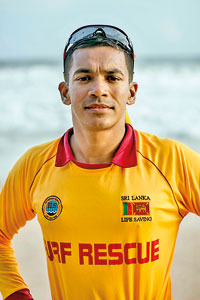News
Freed from shackles many are boozing and drowning in holiday spots

Asanka Nanayakkara
Post-curfew gatherings and outings are increasing, so are an alarming number of drowning related deaths, life savers warn.
Whether it is a boat ride, a family trip with a dip in a nearby tank, lake, river or canal, or having a booze party followed by a swim, or boat ride, drowning in inland waterways are worrying, said Asanka Nanayakkara, president of Sri Lanka Life Saving (SLLS).
This warning comes following a number of deaths reported on an almost daily basis from across the country.
Recently a 38-year-old man, his 13-year-old daughter and another 12-year-old girl drowned while bathing in a water stream near Gerandiella, police said.
Another 21-year-old man drowned while bathing in Samanala Wewa with a group. A 55-year-old man drowned after falling from a makeshift boat in Aluthwewa reservoir. Similarly, in Aralaganwila, a 45-year-old man drowned while fishing in Handapanvila lake. An eight-year-old died after falling from a boat in Uhana recently.
Two young men (22 and 28 years) from Embilipitiya also drowned when they went for a swim in Seethawaka river, a tributary of the Kelani river.
According to Police statistics, there were a staggering 605 drowning deaths last year and among these were 493 males. In 2018, 767 people drowned, the majority of 634 being males.
Senior Superintendent of Police, Priyankara de Silva, the head of Police Marine Division to which the Sri Lanka Police Life Saving belong, said most drowning deaths are the result of alcohol.
“Police lifesaving unit members have been deployed to nearby tanks in Anuradhapura and Polonnaruwa areas where people tend to swim or go boat riding in the wewas. Lifeguards save hundreds of lives annually, but there is a lack of support from local authorities,” he said adding that the century old Police Life Saving Unit has about 200 members but needs to be expanded.
“Training in life saving is no easy task with limited resources. Local authorities especially those who earn income from public attractions should make an extra effort on water safety, such as displaying warning signboards, deploying a lifeguard and creating awareness in schools, community groups etc,” he said.
SSP de Silva said drinking and swimming should be made a punishable offence.
The “Drowning Prevention Report for 2020” prepared by Sri Lanka Life Saving stated that among top drowning locations only 21% are the seas, while the majority are inland water bodies — lakes and others 26%, canals 22%and wells at 18%. Sri Lanka has about 2,300 active lifeguards at 235 lifesaving patrol points and over 300 rescues performed annually.
Only the seas off Western, Southern and Eastern provinces are top drowning locations, while all provinces have rivers, canals, wells and other inland waterways that are deadly locations.
A dedicated unit is needed for water safety, the drowning report recommended, along with implementing the national swim for safety programme for schools, establishing a national drowning data surveillance system, and developing a risk profile for beaches and waterways.
The limited number of lifeguards has resulted in the majority of them watching public beaches where crowds gather, said Mr. Nanayakkara of the SLS.
“The public’s mind set is that drowning happens in sea and that inland water bodies are safe. Compared to other countries ours are relatively safe, but only for those who have swimming skills. Local authorities should put up warning signs and make arrangements to at least deploy a lifeguard at places that have reported drowning cases and have the potential to trigger drowning,” he said.
He said Sri Lanka is yet to identify high risk places.
Deaths of local inland fishermen can be prevented by handing them life jackets, provided by local authorities or the Ministry of Fisheries. Any floating object, even two four-litre water cans can help to float in case of an emergency.
“Drowning is the second cause of accidents in the country; authorities should give more attention to this. Unfortunately there is an absence of a local state body in charge of life saving and is presently not coming under a ministry or a responsible authority. Discussions have been taking place for many years, lifesaving should ideally come under the Ministry of Disaster Management,” he lamented.
Sri Lanka is to host the World Conference on Drowning Prevention in October next year.

